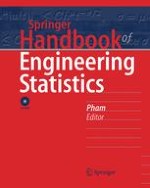2006 | OriginalPaper | Chapter
11. Statistical Methods for Product and Process Improvement
Authors : Kailash Kapur, Qianmei Feng
Published in: Springer Handbook of Engineering Statistics
Publisher: Springer London
Activate our intelligent search to find suitable subject content or patents.
Select sections of text to find matching patents with Artificial Intelligence. powered by
Select sections of text to find additional relevant content using AI-assisted search. powered by
